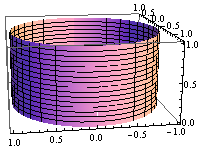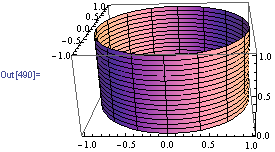How would I plot $x^2+y^2=1$ in 3D (it would form a cylinder)? Since there is no $z$ in the equation, I can't solve for it and use Plot3D. Or can I just put the equation into Plot3D? I am very new to Mathematica.
2 Answers
$\begingroup$
$\endgroup$
2
How about a 3D contour plot.
ContourPlot3D[x^2 + y^2 == 1, {x, -2, 2}, {y, -2, 2}, {z, -2, 2}]
$\begingroup$
$\endgroup$
2
Although Mark's answer is the "natural" one, here are other options just for completeness:
Use Plot3D, after performing a rotation:
Plot3D[{1, -1} Sqrt[1 - x x], {x, -1, 1}, {y, -1, 1}, AspectRatio -> 1]

Use ParametricPlot3D[]:
ParametricPlot3D[{{1, -1, 1} #, {1, 1, 1} #} &@{x, Sqrt[1 - x x], z}, {x, -1, 1}, {z, 0, 1}]

Use RevolutionPlot3D[] after realizing for example that in the semi/plane {y==0, x>0} x takes only the value 1 and z takes any value (freely):
RevolutionPlot3D[{1, t}, {t, 0, 1}]

-
$\begingroup$ Yet another possibility:
ParametricPlot3D[RotationTransform[θ, {0, 0, 1}][{1, 0, r}] // Evaluate, {r, 0, 1}, {θ, 0, 2 π}]$\endgroup$ Commented Sep 17, 2012 at 11:00 -
$\begingroup$ Man, thanks so much for this. This is great. $\endgroup$ Commented Sep 19, 2012 at 2:00
